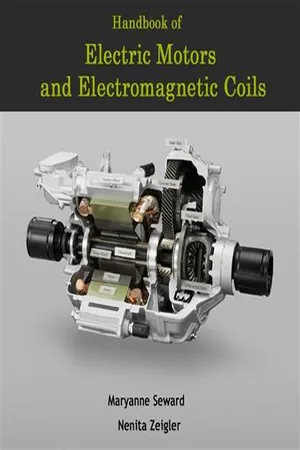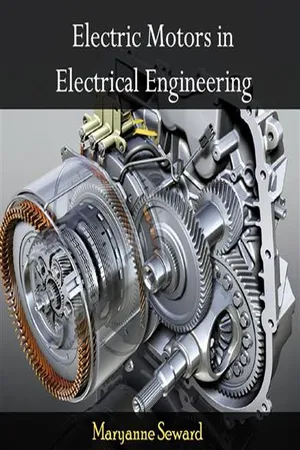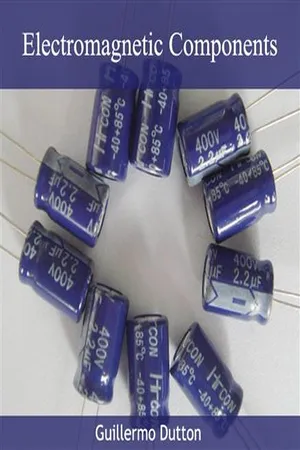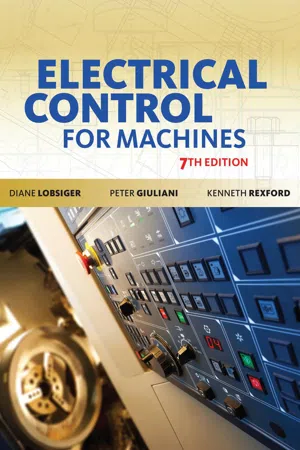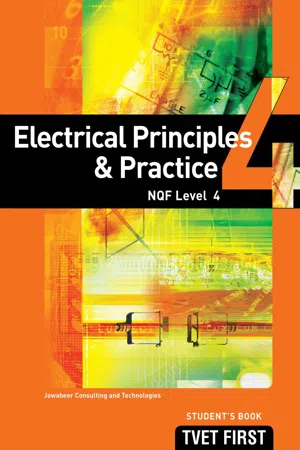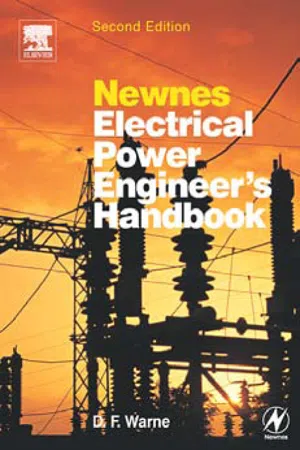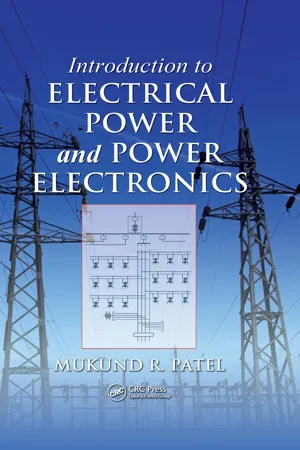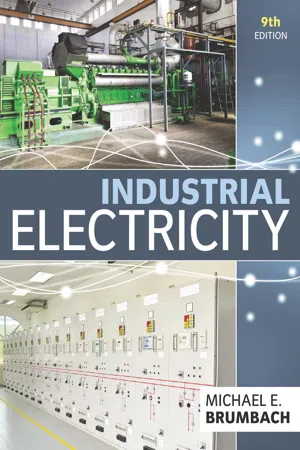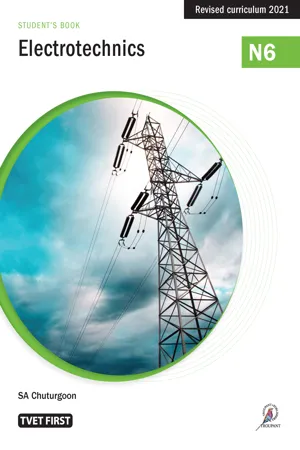Physics
AC Motor
An AC motor is a type of electric motor that operates on alternating current. It consists of a stator and a rotor, with the stator producing a rotating magnetic field that drives the rotation of the rotor. AC motors are commonly used in various applications, including industrial machinery, household appliances, and electric vehicles.
Written by Perlego with AI-assistance
Related key terms
1 of 5
11 Key excerpts on "AC Motor"
- No longer available |Learn more
- (Author)
- 2014(Publication Date)
- Academic Studio(Publisher)
____________________ WORLD TECHNOLOGIES ____________________ Chapter 3 AC Motor An AC Motor is an electric motor driven by an alternating current. It commonly consists of two basic parts, an outside stationary stator having coils supplied with alternating current to produce a rotating magnetic field, and an inside rotor attached to the output shaft that is given a torque by the rotating field. Where speed stability is important, some AC Motors (such as some Papst motors) have the stator on the inside and the rotor on the outside to optimize inertia and cooling. There are two main types of AC Motors, depending on the type of rotor used. The first type is the induction motor, which only runs slightly slower or faster than the supply frequency. The magnetic field on the rotor of this motor is created by an induced current. The second type is the synchronous motor, which does not rely on induction and as a result, can rotate exactly at the supply frequency or a sub-multiple of the supply frequency. The magnetic field on the rotor is either generated by current delivered through slip rings or by a permanent magnet. Other types of motors include eddy current motors, and also AC/DC mechanically-commutated machines in which speed is dependent on voltage and winding connection. History In 1882 Nikola Tesla identified the rotating magnetic induction field principle used in alternators and pioneered the use of this rotating and inducting electromagnetic field force to generate torque in rotating machines. He exploited this principle in the design of a poly-phase induction motor in 1883. In 1885, Galileo Ferraris independently researched the concept. In 1888, Ferraris published his research in a paper to the Royal Academy of Sciences in Turin. - No longer available |Learn more
- (Author)
- 2014(Publication Date)
- Orange Apple(Publisher)
________________________ WORLD TECHNOLOGIES ________________________ Chapter 3 AC Motor An AC Motor is an electric motor driven by an alternating current. It commonly consists of two basic parts, an outside stationary stator having coils supplied with alternating current to produce a rotating magnetic field, and an inside rotor attached to the output shaft that is given a torque by the rotating field. Where speed stability is important, some AC Motors (such as some Papst motors) have the stator on the inside and the rotor on the outside to optimize inertia and cooling. There are two main types of AC Motors, depending on the type of rotor used. The first type is the induction motor, which only runs slightly slower or faster than the supply frequency. The magnetic field on the rotor of this motor is created by an induced current. The second type is the synchronous motor, which does not rely on induction and as a result, can rotate exactly at the supply frequency or a sub-multiple of the supply frequency. The magnetic field on the rotor is either generated by current delivered through slip rings or by a permanent magnet. Other types of motors include eddy current motors, and also AC/DC mechanically-commutated machines in which speed is dependent on voltage and winding connection. History In 1882 Nikola Tesla identified the rotating magnetic induction field principle used in alternators and pioneered the use of this rotating and inducting electromagnetic field force to generate torque in rotating machines. He exploited this principle in the design of a poly-phase induction motor in 1883. In 1885, Galileo Ferraris independently researched the concept. In 1888, Ferraris published his research in a paper to the Royal Academy of Sciences in Turin. - eBook - PDF
Electricity and Electronics for Renewable Energy Technology
An Introduction
- Ahmad Hemami(Author)
- 2017(Publication Date)
- CRC Press(Publisher)
A universal motor is, in fact, a series wound DC motor. We will see how, in accord with the principle based on which it functions, it can use AC electricity as well as DC. There are other types of motors that are either very specific in the way they work or are used for very specific applications. Just to name a few, there are linear motors, which have a linear motion, rather than rotational motion, ultrasonic motors that are very small in size and capacity, hyster-esis motors, step motors, and brushless DC motors (which is, indeed, an AC Motor with a DC-powered driver). Except for the linear motors, which can be used for traction of railed vehicles, the others are normally small (fraction of a horsepower). Also, the term machine cannot be applied to these motors because they cannot work as generators or even if they do, nobody uses them as generators. Before one can learn about how an AC Motor works, it is necessary to understand the concept of rotating magnetic field . All three-phase motors work based on a rotating magnetic field; that is, a magnetic field that, though not visible, has a rotational motion. 11.3 Rotating Magnetic Field Referring to electromagnets (see Section 7.3.2) if a coil is connected to a DC source a magnetic field is generated in the coil, the direction of which is found according to Figures 7.6 and 7.7. Consider now if the source is AC with a frequency of 50 Hz. Again, a magnetic field is generated, but this time its north and south pole swap places rapidly with the change in the current direction (100 times per second). Now, consider three pairs of similar but separate windings that are connected to the three phases of a three-phase supply, each pair connected to one phase. Because the voltages in the three phases are not in phase with each other, the magnetic fields, accordingly, are not reaching their maximum and minimum strength at the same instants. Figure 11.1 shows these windings that are physically placed 120° from each other. - eBook - PDF
Electrotechnics N4 Student's Book
TVET FIRST
- SA Chuturgoon(Author)
- 2021(Publication Date)
- Troupant(Publisher)
249 Alternating-current (AC) machines TVET FIRST Unit 5.1: Three-phase induction motors Definition of alternating-current (AC) machine An AC machine is an electric rotating machine that is used to convert mechanical energy into AC electrical energy (AC generator or alternator) OR to convert AC electrical energy to mechanical energy (motor). Like DC motors, AC Motors are used to convert electrical power into mechanical power (in the form of rotation). An induction motor is an electric motor in which torque is produced by the reaction between a rotating magnetic field generated in the stator winding and the current induced in the coils of the rotor. Unlike in a DC machine, in an induction motor there is no electrical supply to the rotor (only to the stator). Induction motors work on the principle of electromagnetic induction. Three-phase induction motors are the most popular motors used in industry because of their many advantages, as set out in Table 5.1. Table 5.1: Advantages and disadvantages of a three-phase induction motor Advantages Disadvantages • Self-starting. • Very simple construction. • Very efficient. • Available in many sizes. • Have high operating torque. • High starting currents can be limited. • Relatively cheap. • Relatively smaller in size. • Three-phase supplies not readily available. • Complicated starting methods in large motors. • Cannot be used to improve power factor. • Speed control not easily achieved. • Complicated method of limiting high starting currents. • Low starting torque because of reduced rotor resistance. 5.1.1 Construction of a three-phase induction motor Figure 5.2 shows the parts of a three-phase induction motor. terminal box end shield drive shaft bearing stator windings mounting feet cooling fan stator rotor Figure 5.2: Construction of a three-phase induction motor Note Single-phase and three-phase AC systems ● A single-phase system has one live conductor and a neutral conductor. - No longer available |Learn more
- (Author)
- 2014(Publication Date)
- Orange Apple(Publisher)
Tesla would later attain U.S. Patent 0,416,194, Electric Motor (December 1889), which resembles the motor seen in many of Tesla's photos. This classic alternating current electro-magnetic motor was an induction motor. Michail Osipovich Dolivo-Dobrovolsky later invented a three-phase cage-rotor in 1890. This type of motor is now used for the vast majority of commercial applications. An AC Motor has two parts. A stationary stator having coils supplied with AC current to produce a rotating magnetic field, and a rotor attached to the output shaft that is given a torque by the rotating field. AC Motor with sliding rotor Conical rotor brake motor incorporates the brake as an integral part of the conical sliding rotor. When the motor is at rest, a spring acts on the sliding rotor and forces the brake ring against the brake cap in the motor, holding the rotor stationary. When the motor is energized, its magnetic field generates both an axial and a radial component. The axial component overcomes the spring force, releasing the brake; while the radial component causes the rotor to turn. There is no additional brake control required. Synchronous electric motor A synchronous electric motor is an AC Motor distinguished by a rotor spinning with coils passing magnets at the same rate as the alternating current and resulting magnetic field which drives it. Another way of saying this is that it has zero slip under usual operating conditions. Contrast this with an induction motor, which must slip to produce torque. A synchronous motor is like an induction motor except the rotor is excited by a DC field. Slip rings and brushes are used to conduct current to rotor. The rotor poles connect to each other and move at the same speed hence the name synchronous motor. Induction motor An induction motor is an asynchronous AC Motor where power is transferred to the rotor by electromagnetic induction. - eBook - PDF
- Diane Lobsiger, , , (Authors)
- 2021(Publication Date)
- Cengage Learning EMEA(Publisher)
When one of the signals is reversed in polarity, the direction of current flow will be in the opposite direc-tion, resulting in a reversed magnetic field, and a re-versed direction of rotation for the shaft of the motor. A DC motor will generally require more maintenance than an AC Motor. The brushes ride against the commutator to provide current to the armature. Springs push against the brushes so they maintain contact with the commutator as it rotates. The brushes are made of a softer material than the commutator (typically carbon or cop-per), so they will be the wear point in the system. Adjusting the location of the brushes, adjusting the spring tension on the brushes, and replacing the brushes are common issues when working with DC motors. See Figure 13-4 for a cutaway of a typical DC motor. 13.2 DC Motors DC motors can be used when a high starting torque is needed. These motors also exhibit a constant torque over a wide speed range. Another desirable characteristic of DC motors is the ability to control the speed of the motor. However, the speed of the motor will vary as the load on the motor changes. Speed regulation is a measure of how much the motor speed varies when the load changes. The formula for speed regulation is: %R 5 S NL 2 S F L S F L 3 100 where: S NL 5 no load speed (in rpm) S FL 5 rated full load speed (in rpm) The principle of electromagnetic induction states that any time a wire moves through a mag-netic field a voltage will be induced in the wire. When the motor rotates, the armature windings move through the magnetic field generated by the field poles. Therefore, a voltage is induced in the armature windings. This induced voltage is called the counter-electromotive force (CEMF). From Lenz’s Law, we know that the polarity of the CEMF will be in the opposite direction of the polarity of the voltage source. Therefore, the cur-rent flow through the armature will be limited. - eBook - PDF
Electrical Principles & Practice NQF4 SB
TVET FIRST
- Jowaheer Consulting and Technologies(Author)
- 2014(Publication Date)
- Macmillan(Publisher)
Overview In general, AC Motors offer the following advantages: • They are cheaper than DC motors. • They are explosion-proof because there is no commutator; so they are less likely to generate sparks. • They require little maintenance. An AC Motor is particularly well suited for constant-speed applications because its speed is determined by the frequency of the AC voltage applied to the motor terminals. AC Motors are manufactured in different shapes, sizes and ratings for many different types of applications. These motors are designed for use with either three-phase or single-phase power systems. By the end of this module, you will be able to: • Unit 11.1: Three-phase induction motors − Explain the operation of a three-phase induction motor − Describe and explain the operating characteristics of a three-phase squirrel-cage and wound-rotor motor − Calculate the synchronous speed and slip of an induction motor − List losses that occur in an induction motor − Describe the no-load or open-circuit test and blocked-rotor or short-circuit tests and explain why they are conducted − List the factors affecting the performance of induction motors • Unit 11.2: Single-phase induction motors − Draw and explain, with the aid of circuit diagrams, the operation of single-phase AC Motors ( Range: Split-phase, capacitor-start capacitor-run, permanent-capacitor, capacitor-start induction-run, resistance-start induction run, universal and shaded-pole motors ) − Sketch the typical torque-speed characteristics of the AC Motors in the range. 212 Module 11: AC machines Module 11: AC machines Unit 11.1: Three-phase induction motors Operating principles of three-phase AC induction motors Rotating magnetic fields are the key to the operation of most AC Motors. Induction motors rely on rotating magnetic fields in their stators to cause their rotors to turn. 213 Module 11: AC machines A magnetic field in a stator can be made to rotate electrically. - eBook - PDF
- D.F. Warne(Author)
- 2005(Publication Date)
- Newnes(Publisher)
This ability to reduce energy consumption continues to be a major stimulus to growth in the variable speed drives market. Many AC Motors operate at fixed speed, being connected directly to the fixed-frequency supply system, but of the 70 per cent of all electrical power which flows through electric motors, a significant proportion passes through semiconductor conversion in the form of drives. The importance of this technology is self-evident, though the selection of appro- priate equipment is often less clear. It would be a difficult, if not impossible, task to detail every motor type and associated power conversion circuit available, and the focus here will be on those of greatest practical importance in the broad base of industries. All electric motors have a stationary component, the stator, and a moving component, the rotor. In conventional motors, the rotor turns within the stator, but special motors are available for applications such as material handling conveyors where the rotor rotates outside the stator. In linear motors, the rotor moves along the path of the stator. In all cases, the rotor and stator are separated by an air-gap. The stator and rotor usually have a laminated steel core to reduce the losses arising from time-varying magnetic fields (as explained in section 3.2). Almost all electric motors adhere to common fundamental principles of operation. This so-called unified theory of electric machines is important in the design and analysis of motor performance, but is not always helpful in understanding the principles of operation, and is therefore not included here. Only the characteristics relevant to operation and control of the practically important motors are presented. 10.2 The direct current (DC) motor History will recognize the vital role played by dc motors in the development of indus- trial power transmission systems, the dc machine being the first practical device to convert electrical power into mechanical power. - Mukund R. Patel(Author)
- 2012(Publication Date)
- CRC Press(Publisher)
91 4 AC and DC Motors Of the total electrical energy generated worldwide, about 58% is used by all motors combined, about 7% for lighting, and the remaining 35% for heating and other uses. Major types of motor are the synchronous motor, induction motor (also known as asynchronous motor), and dc motor. All have two sets of coils with different cur-rents, say, I 1 and I 2 . The electromagnetic interaction between two currents produces motor torque T m = KI 1 I 2 . If the motor shaft has a load torque T Load < T motor , the motor would accelerate to a speed at which T Load = T motor , where it would stop accelerating and run at steady speed. The motor armature produces back voltage , or its equiva-lent, and draws current from the source that is given by armature current applied voltage back voltage ef = -fective impedance of armature . (4.1) It is important to understand that the armature draws just enough current that is required to develop torque to meet the load torque at the steady running speed. A 100-hp rated motor does not always deliver full 100 hp regardless of the shaft load. The motor delivers what is needed to drive the load and draws power from the source equal to what it delivers to the load plus the internal losses. Thus, the power drawn from the source may be less or more than the rated load depending on the mechani-cal load on the shaft. However, if continuously overloaded without added cooling, the motor would heat up and burn. The shaft horsepower, torque, speed, and kilowatt power delivered by the motor are related as follows: HP or kW lb ft rp m N m r pm = ⋅ = ⋅ × ⋅ T n T n / 5252 2 60 1000 π . (4.2) Table 4.1 gives a breakdown of motor types and their energy usage in various horsepower ratings. It shows that about 98% of all motors are induction motors, which use about 93% of the electrical energy used by all motors rated 5 hp and higher. Smaller motors do not use much energy because their use is intermittent, often less than an hour in a day.- eBook - PDF
- Michael Brumbach(Author)
- 2016(Publication Date)
- Cengage Learning EMEA(Publisher)
Torque is now developed. Shifting the brushes to the position shown in Figure 19–21 causes the motor to develop torque in the opposite direction. The machine starts as a repulsion motor, which develops a very high starting torque. As soon as the rotor reaches approximately 75% of the rated speed, a centrifugal device causes a short-circuiting ring to connect all the segments of the commutator. This converts the machine to an induction motor. The centrifugal device also lifts the brushes off the com-mutator, thus decreasing the brush wear. The repulsion-induction motor differs from the repulsion-start, induction-run motor in that it has two windings on the rotor. One winding is either a squirrel-cage-type or a wound-rotor-type wind-ing. The other winding is the repulsion-type and is S N L 1 L 2 FIGURE 19–21 Repulsion motor: the current flow-ing through the rotor coils develops a torque in a clockwise direction. Copyright 2017 Cengage Learning. All Rights Reserved. May not be copied, scanned, or duplicated, in whole or in part. Due to electronic rights, some third party content may be suppressed from the eBook and/or eChapter(s). Editorial review has deemed that any suppressed content does not materially affect the overall learning experience. Cengage Learning reserves the right to remove additional content at any time if subsequent rights restrictions require it. AC MotorS 389 carry current at any instant. Thus, the resistance leads do not affect the resistance of the armature as a whole. Because of these modifications, AC series mo-tors are more complex in structure and are heavier per horsepower. They are also more expensive than DC motors of the same rating. The operating char-acteristics of AC series motors are very similar to those of DC motors. UNIVERSAL MOTORS A universal motor is a series motor that will operate on both AC and DC. This motor combines the fea-tures of both the AC and DC series motors. - eBook - PDF
Electrotechnics N6 Student's Book
TVET FIRST
- SA Chuturgoon(Author)
- 2021(Publication Date)
- Macmillan(Publisher)
In Module 1 you saw that all given powers are taken as power output values unless otherwise stated. Do you think that the power output of a motor is different from the power developed by the motor? 2. ‘Slip’ refers to relative speed. What do you understand by ‘actual’ and ‘synchronous speeds’ of an induction motor? Figure 4.2.1: A three-phase induction motor being repaired Part 2: Three-phase induction motors Alternating-current (AC) machines Note The full Learning Outcomes for each module are listed in the table at the back of the book. 195 Alternating-current (AC) machines TVET FIRST Unit 4.2.1: Three-phase induction motors Three-phase induction motors (see Figure 4.2.2) are self-starting. Their operation depends on rotor currents that are induced in the rotor bars by a rotating magnetic field. They are considered asynchronous because the actual speed of the rotor is less than synchronous speed. Three-phase induction motors are the most popular motors used in industry. terminal box end shield drive shaft bearing stator windings mounting feet cooling fan stator rotor Figure 4.2.2: Construction of a three-phase induction motor 4.2.1.1 Introduction to rotating magnetic fields In previous levels, you learned that, for the armature of a DC motor to rotate, there must be two magnetic fields: the main magnetic field produced by the field current and the secondary magnetic field produced by the armature current. The challenge with induction motors is to get current to flow through the rotor conductors so that they can produce the secondary magnetic field. Remember, no voltage can be applied to the rotor of an induction motor. In order to understand the operation of a three-phase induction motor, you need to understand the concept ‘relative speed’, Faraday’s law of electromagnetic induction and rotating magnetic fields. We will now investigate these. Relative speed Relative speed is the difference in speed between two objects.
Index pages curate the most relevant extracts from our library of academic textbooks. They’ve been created using an in-house natural language model (NLM), each adding context and meaning to key research topics.
